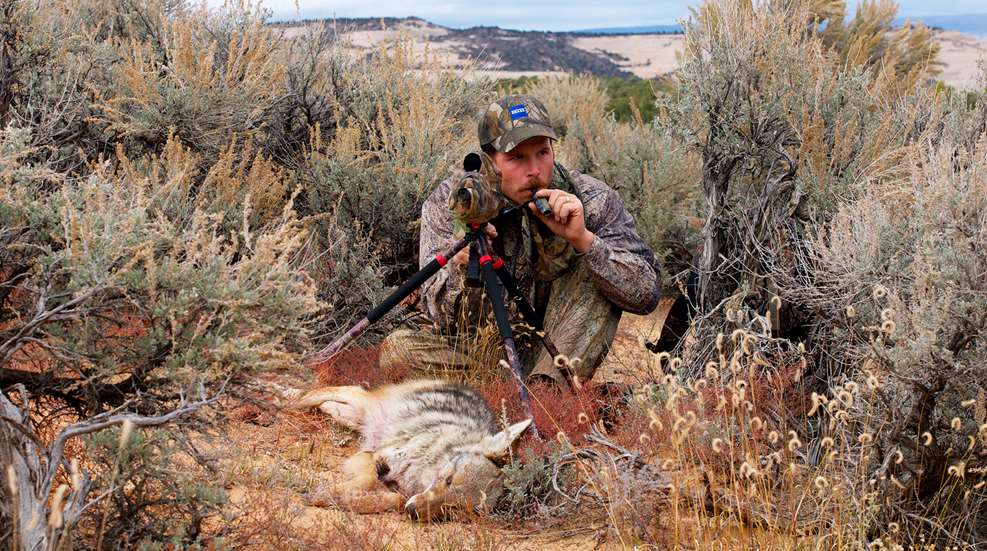
Dawn had come crisp and cold. Sunlight reached tentative fingers across the sage and juniper, stretching across alfalfa stubble and climbing a mesa side. Three coyotes hunted mice in the stubble, sniffing, probing into the five or so inches of snow that blanketed the ground. Occasionally one would make a comical leap high into the air, coming down with front paws and muzzle in a cluster, trying to pin a rodent down and gobble it. Rifles in hand, my son and I stalked closer, sneaking toward a haystack on the edge of the field.
My son was small, so I sent him to the field edge to set up the predator call. The coyotes took notice, but they couldn’t quite make out what he was. Breathless and excited he climbed up the stack and joined me on top, leveling his rifle toward the field. I hit the call button and here they came, three hungry coyotes bent on stealing some breakfast. They covered 300 yards at a fast lope before the lead male became suspicious, stopping to bark and howl. Josiah’s shot ended that performance and the other two coyotes bolted toward the pinion and juniper tree line. I gave my best imitation of a howl and one of them fish-hooked and stopped to look back. It was the last mistake he ever made. Two of the three fawn-eaters had just been converted to fur.

Tools of the Trade
Predator hunting in the West is much the same as any other place, but with a few significant differences. Shot distance can often be long, so you’ll need a fast, flat-shooting rifle. Terrain is regularly wide open, so you’ll want camo that blends with low-growing sage or whatever flora is present. And strong winds are a common adversary, so you’ll need to learn to deal with that when setting up, planning approaches, projecting the sound of your call, and taking long shots. I’m not an expert predator hunter but I have friends who are. Here is the gear they depend on:
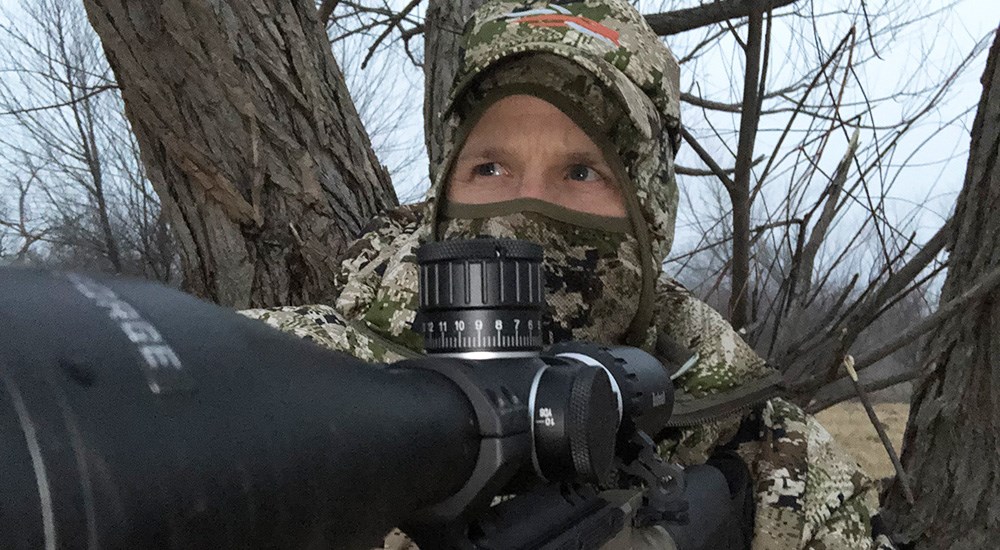
Rifle, Ammo and Optics
Let’s face it: despite how fun all the calls, camo and other predator hunting gadgets are, your most important tool is your rifle. It’s what closes the deal when everything comes together. Use a rifle you’re comfortable with and that’s above-average accurate. Coyotes and other predators are small, elusive targets.
In the words of my buddy Steve Barker (who hunts the Mohave and Sonoran deserts with consistent success) you’ll want a “straight-shooting rifle with a fast flat trajectory.” That pretty well sums it up. Any caliber from .223 up to 7mm will work well, though the smaller rounds recoil less and usually do less damage to the pelts. Steve’s caliber of choice is .223 Remington. Other superb predator-hunting chamberings include the.22-250, 22 Nosler, .220 Swift, .25-06, and 6mm Creedmoor.
Modern Sporting Rifles (MSR, or AR-15 type) are very good for hunting predators because they offer the ability to make super-fast follow up shots. That said, many truly great predator hunters prefer a heavy-ish bolt-action rifle. In many cases they are easier to shoot accurately from field positions, and they feel more natural to hunters who use a bolt-action for all their other hunting. Choose whichever you like best, and then practice until you are completely comfortable with it and accurate enough from field positions to hit a softball-sized target out to 300 yards or so.
Ammunition is a big consideration if you wish to keep the pelts—it’s no good to cut the animal in half with a big bullet. Ideally, predator ammo will punch a tiny entry hole and then expand explosively, not exiting at all. Barker prefers Hornady 53-grain V-Max Superformance ammunition in his .223, and I’m a fan of the same ammo. Most manufacturers build fur-friendly ammo in calibers typically used for predator hunting, so with a little research you’ll be able to find a good load for your chosen rifle.
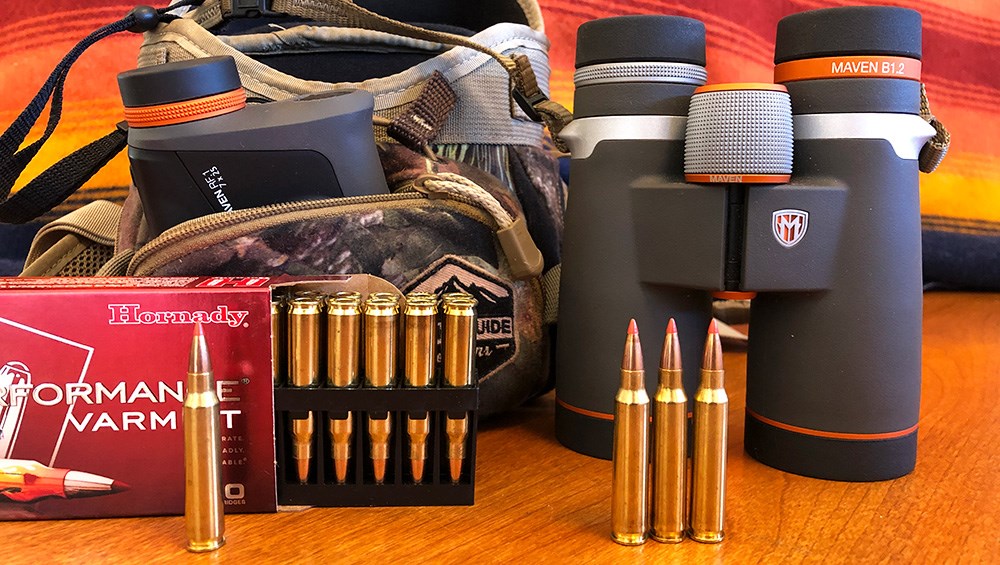
A crisp scope in the 2-12x or 3-15x magnification range is ideal for hunting Western predators. With the magnification turned down it’ll offer a wide-open field of view for close range encounters, yet still possess plenty of magnification for longer shots. If you’d like the ability to take long, sniper-style shots at dogs make sure the scope has a good dial-up turret like a Leupold VX-5HD or VX-6HD. You won’t use the turret when calling predators up close, but it may come in handy if you see one on a distant kill or taunting you from a far-away ridge.
A rangefinder is not absolutely necessary (since you’re shooting a fast, flat-shooting rifle at ranges mostly inside 300 yards), but they are super handy to have. When you first set up you can range a variety of boulders, trees, and bushes so you know approximately how far away that dog or bobcat is when he shows up. A rangefinder will up your game and improve your kill rate.
Binoculars are important as well, enabling you to (careful, don’t move much) check out objects that may or may not be a predator lurking in the shadows or behind a screen of brush.
While hunting, carry your binocular and rangefinder in a good bino pack like those offered from Badlands or Alaskan Guide Creations. It’ll keep your glass clean and protected, and hold it fast to your chest while you hunt. These are available in a variety of shapes and sizes to fit your optics, and many come with dedicated rangefinder or accessory pockets.
The last tool in your shooting kit should be a set of cross-sticks. These come in many forms and heights, so tailor your sticks to the type of hunting you’ll be doing. A simple set of sitting-height shooting sticks will serve well for most of your setups. Steve Barker keeps an additional set of standing-height sticks handy for hunting certain types of cover from a standing position. A set of telescoping sticks like those from Bog Pod or a sturdy tripod like the Spartan Precision Ascent offers a versatile solution that will work well in either scenario.
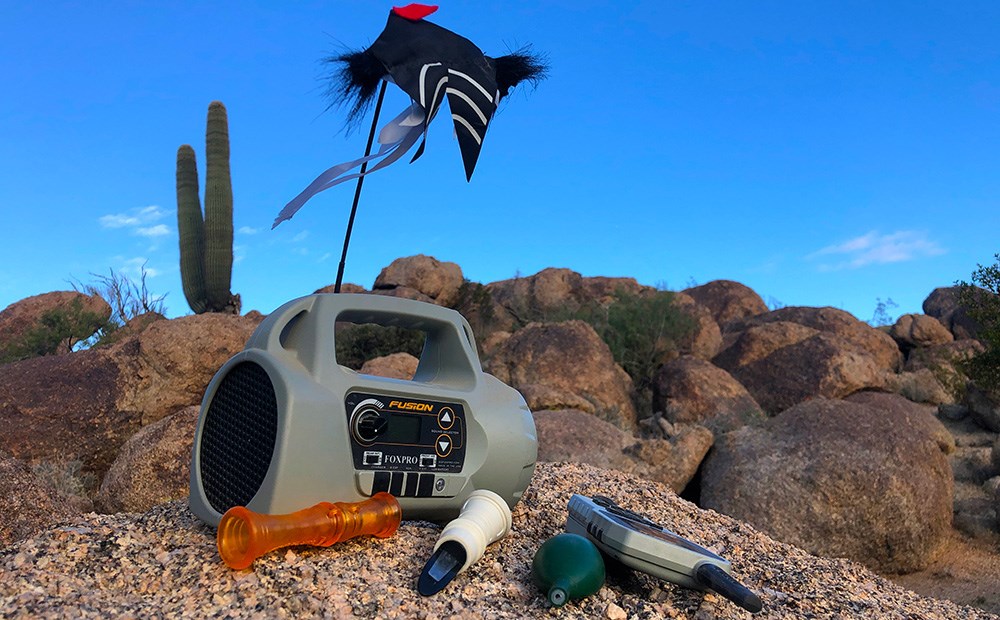
E-Calls and Mouth Calls
Most hunters today use an electronic call, but the successful ones all seem to mix in sounds from hand-held mouth calls. A hunter I know in Texas actually uses two calls in his mouth at once over the sounds from his electronic call, simulating three critters dying or fighting all in the same area. I’m not that talented, but I can run a mouth call to add a bird screech or fox bark over the E-call’s rabbit in distress. It can be a very effective tactic, but keep in mind that if you are making mouth call sounds, the predators will hone in on your precise location. You’ll need to be very still or they will bust you and depart before you even know they are in the area.
I’ve personally called more coyotes in with a Primos E-call than any other, which is ironic because I actually prefer E-calls from Lucky Duck and FoxPro. Whatever you use, try to use uncommon call sounds that the critters don’t hear every day. Unless you’re in an area that never gets any hunting pressure, they’ll be more likely to come to a call that’s unfamiliar, especially if you mix in a few mouth call sounds to give the impression that there are other scavengers already in the area.
A spinning or flapping decoy can add a realistic touch to your setup. A year or so ago Steve and his daughter Camree were in the middle of a setup when a grey fox dashed in and grabbed their spinning decoy and made off with it, still spinning and flapping. Steve doesn’t usually shoot foxes, but he didn’t want his decoy to disappear forever so he flattened that ol’ decoy-snatcher. Old-time trappers and callers would sometimes hang a feather on a string to spin and dance in the breeze, drawing and holding the predator’s attention.
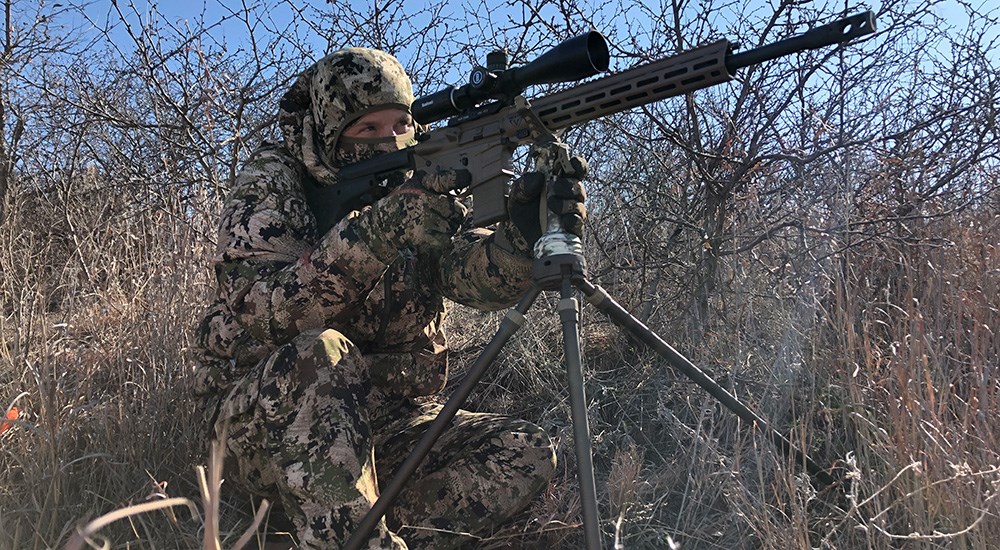
Clothing
You’ll want to wear comfortable clothes sporting a camouflage pattern that merges into the native flora and terrain. Dress strategically so you don’t get overheated while hoofing it 400 yards to your setup, yet stay warm while sitting motionlessly for 45 minutes. Your hands and face make bright warn-a-predator signals unless you cover them with camo gloves, a hat and a facemask. Try to set up below the skyline, with a bit of brush behind and around you to break up your outline. Lastly, carry a foam pad or small stool so you can sit comfortably enough to stay focused through a long calling setup.
If you will be hunting certain areas in Arizona, California, Nevada, New Mexico and Texas during the warm season (April through October), it’s good idea to wear snake gaiters or boots. Snakebite is never a good thing, and is guaranteed to spoil your predator-hunting fun. Don’t let the Nope-Ropes keep you out of the field, just be aware. Who knows, you might even go home with a couple cool rattles tucked in your hatband.
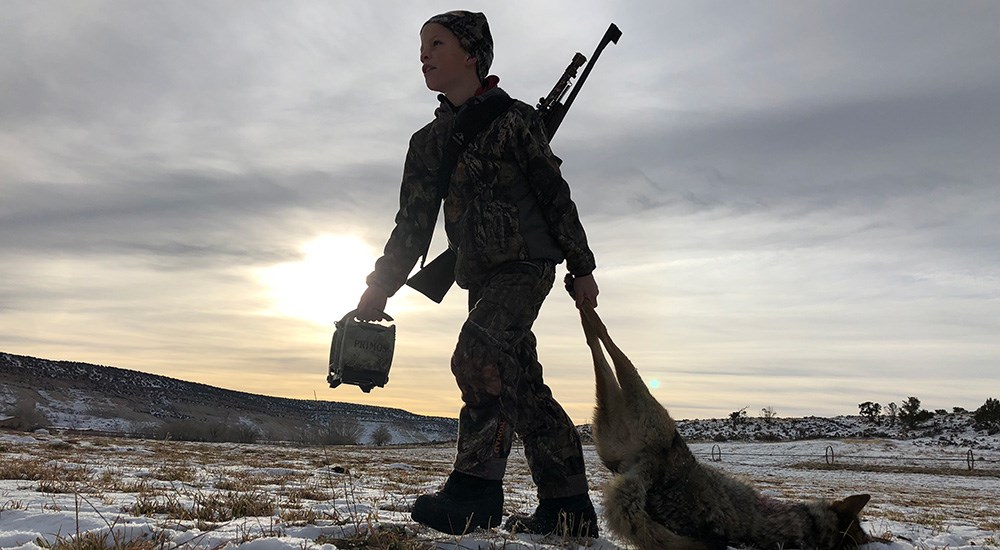
Conclusion
The West can be an awesome place to hunt predators. Update your gear so it’s prepared to meet the challenge, pack a water bottle and wear good walking boots, and expect to work hard. The hunting might be difficult and the critters wary, but there’s plenty of space and adventure awaits.


































